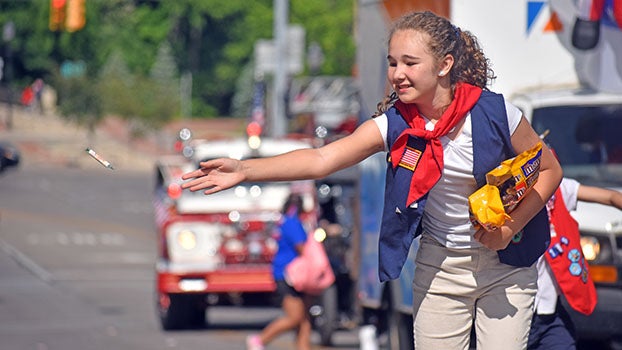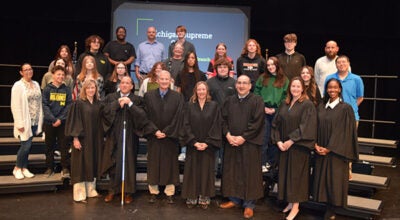Birds of prey fill Conservation Club
Published 8:37 am Thursday, April 1, 2010

Nancy Sloan of Howell Nature Center at Dowagiac Conservation Club March 31 with a great horned owl she has been associated with for 22 years. (The Daily News/John Eby)
By JOHN EBY
Dowagiac Daily News
A fib parents tell their children is that a baby bird touched by a human will be disowned by its mother.
No such shunning takes place because of birds’ lousy sense of smell – except, ironically, hissing turkey vultures, carnivores which gorge on pungent carrion.
Decaying carcasses are neutralized by vultures’ amazing digestive systems.
Their heads are bald the better to plunge into a bloody, maggot-infested body. A four-pound migrating bird, they boast six-foot wing spans and iridescent blue feathers when viewed in sunshine. Cars would be their chief predator.
If vultures happen to find an especially large dead animal, they gorge themselves until they are too full to fly.
If something corners them or threatens them at that point, projectile vomiting lightens the load for flight.
“Take my word for it, what they eat doesn’t smell very well going in the first time,” Kathy Frantz remarks. “Coming back out does not improve that aroma. Number one, it lightens them so they can get off the ground. Number two, it startles the predator so they can make their getaway.”
Bald eagles milk their majesty as the symbol of America, relying on their patriotic reputation to gloss over less savory aspects of their character such as thievery.
Where adaptable owls borrow nests but do not build them, stick-stacking eagles have been known to create two-ton abodes nine feet deep.
Owls eat mice, frogs and rabbits, but it and red-tailed hawks are the few birds which consume skunks.
A hawk could perch on the goalpost at one end of a football field and see a pea in the other end zone.
They eat squirrels, rabbits, chipmunks, snakes and frogs. They sleep at night, contrary to owls, so they could inhabit the same territory without competing.
This hawk and vulture are roommates.
When the vulture escaped, a nature center director who fished baited his hook with a big, fat, juicy rat instead of a worm and reeled in the elusive bird when it stumbled upon lunch in the woods.
Frantz and Nancy Sloan of Howell Nature Center made a 2 1/2-hour trek from Livingston County Wednesday night to show a capacity crowd at Dowagiac Conservation Club what their support provides the youth education program.
Birds of prey they exhibited included owls (great horned and smaller Eastern screech, which its name aside whinnies like a horse), a red-tailed hawk which lost the balance necessary for flight colliding with a windshield, a 200-mph peregrine falcon, the vulture named Egor and a fish-favoring eagle which frowns on flash photography.
Birds of prey use sharp talons to swoop down and snatch up smaller animals.
How those talons work Sloan compared to claw arcade games where you put in money and try to grasp a prize.
“This owl cannot eat insects because his feet are too large,” she said.
Sloan has worked with this particular three-pound owl for 22 years. Its life expectancy in the wild would have been 13 years; in captivity, 25 years.
In January, the club sponsors the Hunters Rendezvous, followed in February by the Wild Game Dinner.
“Profits generated by those two events fund the youth education program,” according to Richard Atkinson. “We do four hunter safety programs a year for 150 to 200 kids on an annual basis. We had a youth pheasant hunt for 18 kids a couple of weeks ago. We have Tracks magazine that goes to local schools. Schools in our area of responsibility we consider to be Eau Claire, Dowagiac, Cassopolis and Marcellus. Decatur has its own conservation club. We also have, of course, the (1 1/2-hour) program we’re going to see tonight, Wildlife Encounters/Birds of Prey.”
Frantz said their nature education and conference center with facilities to rent for retreats, family reunions, weddings and her brother-in-law’s memorial service, is located midway between Lansing and Detroit, off I-96.
Likening the wildlife rehabilitation center to a hospital for wild creatures and birds, Frantz said Howell Nature Center also has high ropes and low ropes challenge courses, Michigan’s highest climbing tower and a global village to illustrate how others live around the world.
It operates summer residential camps.
Once their patients mend, “We release them back into the wild,” Frantz said. “We want them to live outdoors as nature intended. If they’re babies, separated from their parents, we raise them to be wild. We do not let them think people are their buddies. Animals have to fear humans to survive other predators.
“We feed them the kind of food they’re going to need to look for in the wild – not Kentucky Fried Chicken, hotdogs and marshmallows, which turns them into animals that raid garbage cans, which also gets them in trouble with people.”
Sloan showed how owls can turn their heads all the way around because of 14 neck bones, compared to seven in humans. It can locate a mouse tunneling in snow. Soft feathers muffle the sound of its flight, with the tradeoff that the non-migratory bird cannot fly very fast.
The owl has three eyelids. A top comes down. A bottom comes up for sleeping. A third goes across to help protect the eye. It can see through it and continue flying.
“Mostly feathers,” a skull is much smaller than the bird perched on her gloved hand. Its bones are hollow. Eggs are round.
An owl cannot roll its eyes around in its head.
Rather, they are fixed, like headlight beams, “so we always know where the owl is looking,” Sloan said. “The eyes take up most of the skull. The brain is about the size of a pea.”
Females are bigger and have a seven-note call, compared to five for males.
A red-tailed hawk starts out brown all over for camouflage.






